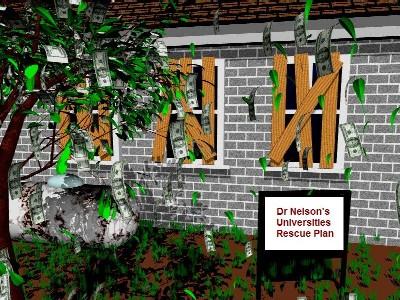|
News & Views item - May 2005 |
![]() One of
Dr Nelson's Greatest Spins, or Has He Now Put A New Gag Writer on His Staff.
(May 6, 2005)
One of
Dr Nelson's Greatest Spins, or Has He Now Put A New Gag Writer on His Staff.
(May 6, 2005)
On May 4 the Minister for Education, Science and Training, Brendan Nelson, released two research reports commissioned by him from the University of Technology, Sydney (UTS): Salary Relativities and the Academic Labour Market and Australian Academic Salaries Time Series Project 1977-2002. The ABC and the broadsheets immediately picked up on the released reviews. They highlighted, as The Australian headline put it "Professors $35,000 worse off than they were in the 1970s" and followed with "Professors could be earning nearly $135,000 a year if salaries had kept pace with the growth in average weekly earnings. Instead, Australia's professors are being paid just over three-quarters that amount, about $100,000."
Quite true, but nonetheless misleading as shown by the chart (Fig. 1, page 10) from the UTS review by Michael Horsley and Greg Woodburne on "Salaries Time Series".
Modified by indicating the Prime Ministers of the day
Almost all of the decline in salaries took place by 1983 and academic salaries relative to average weekly earnings have remained stable since 1983, i.e. following the replacement of Malcolm Fraser's Liberal - National Country Party Coalition by the Australian Labor Party led by Bob Hawke.
Furthermore, the review on "Salary Relativities" by Mike Horsley, Gayle Martin and Greg Woodburne found "The relative decline in academic salaries identified in Australia is a world wide phenomenon. In the UK the British higher education academic staff unions have produced data that show academic salaries were cut in real terms in nine of the years between 1990-91 and 2000-01, [and] while average earnings rose by 44 per cent over inflation from 1981 to 2001, academic salaries rose by only 7 per cent above inflation."
Then turning to the situation in Canada the reviews found:
In Canada, the issue of competitive academic salaries is exacerbated by the proximity of the United States, which makes the lure of higher salaries even more attractive. The Federal Government in Canada has responded to this challenge by providing major funding increases for research in Canadian universities, thus easing the financial burden on the provinces, which constitutionally have the responsibility for university funding.
Funny, the good doctor didn't happen to mention that.
And with regard to the United States, "Universities in the USA have not been immune to the pressure on academic salaries from the private sector and from one another. Because of the availability of salary data, this competition among universities is continuous and well informed."
The overall conclusions of the review are quite interesting when judged against the comments made by the spin doctor from DEST. He says, "While Australian universities are making use of salary loadings and other incentives to attract new academic staff and retain existing staff, there is a pressing need for more flexible work arrangements to attract and reward high-performing staff." The obvious implication -- Australian Workplace Agreements will solve the problems.
But Horsley, Martin and Woodburne don't appear to agree. They leave their readers with this take home message:
The increasing provision around the world in university student places and in research funding will continue to increase the demand internationally for academics. This pressure will be exacerbated by the coming retirement of a significant proportion of the existing academic workforce.
Difficulties in recruiting academic staff will continue because of the comparative attractions of the private sector labour market. Private sector positions are increasingly attractive not only because of their better salaries and career prospects, but also because of the greater flexibilities being shown by employers.
Because of the combination of these factors, it seems most likely that Australian universities are going to face increasing competition for high quality staff. Being able to respond flexibly to this challenge in individual cases will go only so far. Universities will need access to additional funds if they are to continue to attract and hold academic staff. (our emphasis)
A range of reports have established that, internationally, academic salary relativities with the private and public sector have declined. Chapter 6 re-examines traditional Australian data and develops new ways of conceptualising and measuring academic/private sector salary relativities.
It is becoming obvious that Brendan Nelson is treating Australia's universities and its academicians with increasing disdain if not outright contempt.
Earmark additional funding so as to return support to at least the governmental percentage of GDP the universities received in 1996 in order to reverse the decay of university infrastructure and the diminution of staff? What an absurd idea.
And is the National Tertiary Education Union telling porkies when it says:
NTEU estimates show that the funding universities receive for government-supported students (including students' HECS contributions) fell in inflation adjusted terms by about $1740 per student or 13% between 1996 and 2003. This represents a real cut of more than ¾ billion dollars ($784m) in university funding for the year 2003 alone, when compared to 1996. This fall in real funding is primarily due to the 5% cut in government funding in 1996 and a failure of successive governments to index universities grants to compensate for cost increases let alone inflation.
Perhaps Dr Nelson has a plan to send out instructions for planting money trees and infrastructure creation bushes on university campuses. They would beautify the higher education sector no end.
